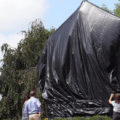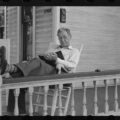Writing by Degrees: the Program Era

The Program Era
by Mark McGurl
Hardcover, $35.00
Harvard University Press, 2009
Just as Hugh Kenner’s formidable 1973 classic The Pound Era traces innovations in literature between the world wars by following the literary juggernaut Ezra Pound, Mark McGurl takes the period after World War II for the start of his equally ambitious historical study of American literature. Rather than follow the influence of one personality, however — McGurl is unable to find a singular Pound-like figure in the postwar period — The Program Eraconcentrates on the influence of creative writing programs on contemporary writing. However much could also be said about poetry, drama, and creative non-fiction — the other programmed pathways creative writing students find themselves placed on — McGurl limits himself to studying trends in postwar fiction, presumably to make his task more manageable.
He begins by creatively, if somewhat arbitrarily, dividing the whole corpus of postwar fiction into three categories that he calls technomodernism, high cultural pluralism, and lower-middle-class modernism — the three bastardized, and we should say institutionalized, descendents of both the experimental high modernism of Joyce and Faulker and the professionalism and craft of James and Hemingway. In clever if overly-indulgent diagrams, McGurl charts these three categories: technomodernism as exemplified by the technicity of a writer like Thomas Pynchon; high cultural pluralism hinging on ethnic concerns in work by writers like Sandra Cisneros; and the lower-middle-class modernism of Raymond Carver and Joyce Carol Oates who dutifully chronicle the mundanity of work.
The means of production of these postwar descendants of modernism are, as McGurl argues, profoundly different from those of their forbears. Gone are the days of Ezra Pound in the cafés of Paris, socializing with Dadaist and Surrealist artists like Marcel Duchamp and literary figures like Basil Bunting and Ernest Hemingway (who taught Pound — rather unsuccessfully — to box). After World War II, the spontaneous literary Petri dish of the café — where intellectuals and artists of all stripes once met to converse and create — was replaced with the classroom: a standardized laboratory for producing creative writers, or, more often in practice, teachers of creative writing who would then go on to teach future classes of creative writing students.
How did we move from the café to the classroom, and from the strong pull of individual genius and personality — Pound and Joyce, Hemingway and Faulker — to the doughy group workshops from which M.F.A graduates rise like cookie-cutter cookies? McGurl argues persuasively that creative writing programs piggybacked on the postwar growth and development of mass higher education in America,
In the 1940s, fewer than 10% of traditional college-age Americans were attending college of some kind; by the 1980s more than half of them were doing so, and the very concept of the delimited college age, with the rise of continuing education, job retraining, and other part-time extension initiatives, was beginning to weaken somewhat. During this period universal access to higher education became a widely shared, if only partially realized, national ideal embodied in educational grant and guaranteed loan programs offered to individual students on an unprecedented scale.
Government acts like the G.I. Bill of 1944 allowed huge numbers of returned war veterans to go to college, and two decades later the Higher Education Act provided unprecedented opportunities for tuition assistance for needy students. In the decades after World War II, more and more people were able to — and did — go to college. McGurl notes that the hard sciences, in particular, were given a push during the Cold War as the U.S. engaged in a dizzying technological race with the Soviet Union. But how does creative writing fit in the rise of mass higher education? Creative writing is an anomaly in academia — it is neither analytical nor practical in the way most academic disciplines are. As McGurl is careful to point out,
the discipline of creative writing is an odd but, to all appearances, healthy duck. With its penchant for specialized vocabularies and familiarity with the less-traveled regions of the library, literary scholarship is at least partly in sync with the scientism of its wider institutional environment, the research university. Creative writing, by contrast, might seem to have no ties at all to the pursuit of positive knowledge. It is, rather, an experiment — but more accurately, an exercise — in subjectivity.
An eminently appealing exercise in subjectivity, for certain. Part of the appeal of the creative writing program in the university is its exoticness, its lure of otherness. As McGurl notes, the university writer-in-residence is a type of outsider-insider, both part of the academic world and granted a privileged position outside it as artist. The English professor is staid, tweedy, methodical, thorough, analytical, and predictable. The artist — the writer! — on the other hand, is a wild card, mysterious, unpredictable, even quasi-mystical in the eyes of his or her aspiring students. A rara avis in the university and a treasured one. Not only are students drawn moth-like to the flame of the Pulitzer Prize–winning, best-selling writer-in-residence, but the university administration is shrewdly aware that these writers not only fill the institution’s coffers, but also give it more prestige, adding to its “portfolio of cultural capital.” As McGurl notes — quite perceptively — star writers and writing programs,
are somewhat like varsity athletes, but whereas varsity athletics typically symbolizes the excellence of competitive teamwork, creative writing and the other arts testify to the institution’s systematic hospitality to the excellence of individual self-expression.
It would take a very naïve individual not to realize that these programs have fared so well in universities for marketing reasons. Creative writing classes are a big draw at both the undergraduate and graduate level, and students are willing to shell out big bucks to take them and leave with the a B.F.A. or M.F.A. The prize-winning published novelist in the faculty — and many are prize-winning — is just another sparkling gem to draw students in, like the multimillion dollar gyms and swimming pools savvy institutions make sure to include in their package.
So, with the increased accessibility of higher education after World War II came the trappings of the institutionalized writing program — an ersatz Parisienne café that carried out that most paradoxical of tasks: the institutionalization of creativity. McGurl notes that it is this paradox in particular that makes so many — critics and writers alike — skeptical about the whole enterprise of teaching writing: the literary critic John W. Aldridge argued that writing programs merely create “clonal fabrications of writers” rather than real writers, and New Journalist Tom Wolfe also famously spoke out against writing programs. (It is worth noting, with some irony, that Wolfe was friends with Ken Kesey — a famous, if idiosyncratic, M.F.A. graduate.)
McGurl cautiously suggests, however, that writing programs are — or at least can be — a good thing for both readers and writers, and that our romantic predilection for what we see as “genuine” literary creation — pages scrawled out by a penniless, possibly drunk or hopelessly depressed, artist in his urban garret — is a sorely misplaced anachronism. From the very start of his 400-plus page treatise, McGurl is careful to make clear that he has no dog in the race. He explains,
Almost the first decision I made when beginning to research this book several years ago was to resist the strong pull of opinion that hangs around the program — what I referred to earlier as the “pro and con” of it — which seemed anathema to the scholarly disposition I wanted to adopt. Not only would the platitudes of pro and con impede the fascinatingly complex history I wanted to relate, but they could not begin to address what seemed to me the truest and deepest irony of the creative writing program … the very idea of systematic creativity which the proximity of “creative” and “program” in the term “creative writing program” brings to mind.
Despite his professed objectivity, by the end of his work, McGurl has convinced himself, and with any luck his reader, that this systematic creativity — a jumbo shrimp of a paradox — has produced and cultivated more literary talent, resulting in “a system-wide rise in the excellence of American literature in the postwar period.”
The Program Era is, as a text, both anecdotal and systematic — not a surprise given the subject matter. While McGurl runs through many case studies of famous and less-famous M.F.A. graduates including Toni Morrison, Raymond Carver, Joyce Carol Oates, Flannery O’Connor, and Ken Kesey, he points out that he could have chosen any number of novelists and short story writers. To some extent, his choices were arbitrary, and not necessarily exemplary. Some of the less canonical writers and works he discusses — the “technomodernist” novel Giles Goat-Boy by John Barth, for instance — are intriguing partly because McGurl isn’t simply rehashing old standards. Still, his discussion of household-name writers can also be insightful. The fact that Ken Kesey, psychedelic hippy-king of the Merry Pranksters, was both a prominent countercultural figure and a product of the system makes one think about where, exactly, countercultural cachet comes from, and how, exactly, Stanford University’s creative writing M.F.A. launched Kesey’s career and provided the time and resources that allowed him to write One Flew Over the Cuckoo’s Nest — now no longer seen as countercultural but part of the college canon. Certainly, Kesey downplayed his privileged education and the doors opened by that M.F.A. program, despite the fact he went on to teach writing at the University of Oregon. Kesey’s own teacher, Wallace Stegner, — whom Kesey disliked and disagreed with on many issues — was himself a graduate of the Iowa Writers’ Workshop and had founded the program at Stanford.
Alongside anecdotal accounts of authors who are products of the M.F.A. system, McGurl turns a dispassionate historian’s eye to the programs themselves, dutifully recording the founding and rise of the Iowa Writers’ Workshop in 1936, the programs that began to follow in the 1940s, and the educators and administrators, like Iowa’s Paul Engle, who famously directed the program for many years from the start of the 40s to the mid-60s. Engle enthusiastically believed that writing could be taught, that native talent could be nurtured and disciplined under the cool, impartial gaze of one’s peers and mentors. Control, above all else, was important for the budding writer, and Engle valued close editing much more than simple expression — a notable contrast to the “find your own voice” aesthetic that started to become trendy in the 60s and 70s. Engle once claimed that the Iowa Writers’ Workshop did “not pretend to grow blonde curls on an autumn pumpkin. . . . Good poets, like good hybrid corn, are both born and made,” and, as director and cultivator-in-chief at Iowa, he saw it as his duty to facilitate the making.
Iowa was the bellwether, but by 1945, Stegner had followed Engle’s lead by founding Stanford’s program, and other programs had been started at Boston University, the Universities of Indiana, Florida, and Denver, as well as Cornell, and Johns Hopkins. After the success of these first M.F.A. programs, the number of degree-granting creative writing programs across the country began to grow exponentially,
The handful of creative writing programs that existed in the 1940s had, by 1975, increased to 52 in number. By 1984 there were some 150 graduate degree programs (offering the M.A., M.F.A., or Ph. D.), and as of 2004 there were more than 350 creative writing programs in the United States, all of them staffed by practicing writers, most of whom, by now, are themselves holders of an advanced degree in creative writing.
McGurl notices that this figure quickly doubles if we are to take into account undergraduate writing programs as well. The Program Era, more than anything else, is a history of the program — more than any of the individuals produced by it — and of the program’s relation to higher education throughout the second half of the twentieth century.
The book is also a history of the program as a distinctly American phenomenon, and the subtitle could be more appropriately expanded to “Postwar Fiction and the Rise of Creative Writing in America.” Where else could commerce — the marketability of teaching writing — be linked to romantic individualism so successfully? “Creative writing,” McGurl observes, “is in sum, as American as baseball, apple pie, and homicide. And yet there is evidence that after fifty years of standing more or less alone, this is beginning to change — evidence that writing programs are, like fast food and nuclear weapons and (perhaps more relevantly) mass higher education, beginning to proliferate abroad.” Slowly, we see the increasing globalization of the writing program, as more and more countries — the majority of which are still Anglophone — are producing M.F.A. graduates in creative writing.
With mass-produced literature, we now have mass-produced writers as well, both in America and increasingly across the (Anglophone) world. This does not mean, however, that all M.F.A. writing reads like it came off an assembly line: without the M.F.A. program, we might not have had the dark fables of Flannery O’Connor nor the terse stories of Raymond Carver — and the variety of postwar writing that hinges on concerns about class, ethnicity, and technology. McGurl dutifully brings us to the conclusion that our cache of books — both good and bad — would be much smaller without the program.
With so many new writers, however, where are the readers? While creative writing programs pump out new novelists and poets, fewer people seem to be reading, whether or not this really is the case. With his focus on the program, McGurl does not devote space to discussing how readers and patterns of reading have changed in the postwar period — surely the topic for a companion book. He does, however, limit his focus, and manages to do a decent job providing a detailed and thoroughly documented survey of postwar fiction and creative writing programs. While not a thrilling read, The Program Era does offer insight into how higher education and market forces have changed the way we write, and how we came to be worlds away from the Pound Era.
About Nora Delaney
Nora Delaney is a poet, translator, and critic. She received her PhD from the Editorial Institute of Boston University. Her writing can be found in Literary Imagination, Two Lines Online, Absinthe: New European Writing, Subtropics, Pusteblume, Little Star, Fulcrum, The Arts Fuse, and elsewhere.





